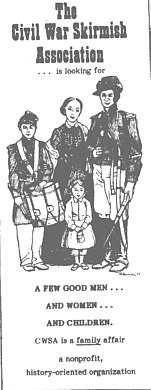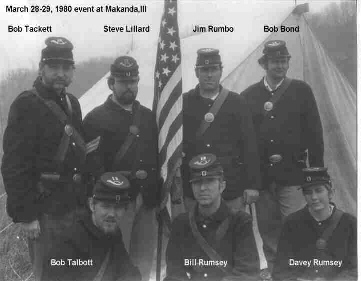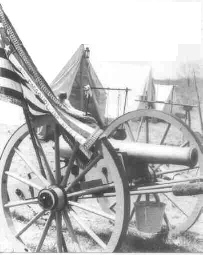|
|
|
If you have followed my story so far, gentle reader, I told you how I learned about the Civil War through an association with Dr. Leslie Anders, professor of History at Central Missouri State University; how obscure and ancient battles came to life via eloquent lectures that captured my undivided attention; how a simple question on Civil War ancestry by Dr. Anders, would take me a year later to the grave of my great great grandfather in Morgan County, Missouri. I also told you how I came to witness my first Civil War Reenactment in nearby Lexington, Missouri, and how through continued research into the Civil War, I stumbled across an ad in a Civil War publication calling for recruits.
After seeing the ad in the CIVIL WAR BOOK EXCHANGE, it took me about 24 hours before I had a letter in the mail. On December 4, 1979, I received a reply from a Jack Puett from Topeka, Kansas. The note was written on stationary with the banner, TWELFTH MISSOURI CAVALRY C.S., emblazoned at the top. In smaller copy: member unit, Civil War Skirmish Association . In his letter, Mr Puett first welcomed me and my interest in the hobby. He was kind enough to suggest some units in the Kansas City area that I might contact; including the 13th Missouri Vols Inf. US. out of Higginsville, Mo (that was just a short 15 minutes north of Warrensburg). Mr. Puett told me what the main membership requirements were: that if I was really interested, I'd need to purchase a CWSA approved musket and uniform-all within at least a year of joining. In conclusion, he stated the 12th Missouri Cavalry was not a bunch of "red neck rebels or booze hounds", but not a bunch of "nit-pickers" either. Their goal was to "shoot in team competition and proudly represent the honor and dignity of Gen. Joe Shelby's Brigade." I had my heart set on becoming involved with a Union group, in honor of my great great grandfather, so I soon sent a letter to Mr. Bill Rumsey in Higginsville.

So I visited the post office once again, and less than a week later, I received not one, but two letters. One from Bill Rumsey and one from a Mr. Steve Lillard. Bill gave me the same kind of background of what the hobby was all about as Jack Puett did. He mentioned that he came into Warrensburg once a week, and would be glad to meet with me to discuss the hobby. Steve Lillard, on the other hand, gave me a price list of some of the things I'd need to purchase if I was intent on joining the group. For example: a cartridge box for $24, with sling, an extra $7. He told me that a replica Enfield 3-band musket would cost about $185. He stated that they made their own uniforms and had patterns for both a jacket and trousers. Now both men had stated that their unit, the 13th Missouri, was a "skirmish" unit. That is they dress the part of a Union soldier, but their mission is to compete with other "skirmisher's" in shooting at targets. It still seemed ok by me, so before long, I arranged to meet with these men.
Sometime during the Christmas holiday, Bill Rumsey paid me a visit. He was a tall red-headed fellow in his mid thirties if I recall. He had a 16 year old boy at home and another about 10, I think. Don't remember what all was said, but he gave me a trouser and coat pattern. I still had my Navy blues with me, and Bill said I could make a coat out of those. Sky blue wool for trousers, he recommended, could be purchased from CLEARBROOK WOOLENSHOP, from Clearbrook, Virginia. He said he made the forage caps for all the guys in the 13th and would make one for me for $8. I believe he left me a couple of other price list's including one from DIXIE GUNWORKS, in Union City, Tennessee.
I paid a visit to Steve Lillard, up in Higginsville, very soon after the visit by Bill Rumsey. Steve was a big bear of a man (not too tall, not fat either), with a full black beard and pleasant demeanor. I was invited into his home to look over all his equipment: musket, leather gear, etc. He said he was in the process of building a 6/7 scale Napoleon field piece; which he showed me in his garage. The wood was pretty much finished; the main frame,axle, and wheels. He had someone working on the metal pieces and was in the process of acquiring a barrel. All in all, he hoped to have it ready by April, when a live shoot was planned at Kearney on the site of the Jesse James farm. I told him of my visit with Bill Rumsey and the items he suggested I purchase. Steve helped me on the selection of my firearm by pulling out a copy of the DIXIE GUNWORKS catalog. He suggested on the London Armory brand Enfield, as it was one of two most common weapons used by US and CS soldiers. Another thing; they made their own bullets. Steve worked for some electrical outfit (if memory serves me) and had access to scrap lead. During the winter, he melted the lead and made the bullets in a mold. He gave me a coffee can full of conical shaped bullets-called Minie Balls, after the original french designer of the bullet.
Needless to say, the first opportunity I got to visit my mother-in-law, I commissioned her to tear up my old Navy blues and begin construction on a federal issue sack coat (I still have it to this day; a little the worse for wear perhaps). In the meantime, I placed an order with CLEARBROOK WOOLENSHOP for enough sky-blue kersey wool for trousers. Steve had given me four reproduction brass buttons for the coat, and about a dozen pewter buttons that would go on the trousers. He also gave me an old pair of cotton suspenders (soldier's didn't wear a belt to hold up their britches). To make a long story short, by the time March 1980 rolled around, I had a four button sack coat and a pair of sky blue trousers ready to go. I also had to have a white cotton overshirt (I forgot to mention) and my mother-in-law was kind enough to include that in her work load as well. The pattern was a Missouri Boatman's pattern, if I recall. Plain white cotton, long sleeved that pulled on over the head, and had a draw string tie at the neck. I later added two buttons and removed the draw tie.
The reason March 1980 was important, was because Bill and Steve had told me of an event that was planned at Makanda,Ill. It would be during the weekend of March 28-29 and several of the other members of the 13th Mo. would be in attendance. Needless to say, I was very excited and was on pins and needles in anticipation of this: my first outing at a Civil War event. It was billed as a "skirmish" meaning live shooting at targets, but there was to be other Civil War units there; Union and Confederate, all in competition for trophy's or whatever-I didn't know. I didn't have a musket of my own yet, but Steve said I could use an extra one he had.
THE BIG WEEKEND!!
Friday afternoon, March 27 finally came. With what meager possessions I had, my wife drove me up to Lexington where I would ride to the event with Steve Lillard and the rest of the 13th Missouri.  Besides Steve, Bill Rumsey, his son Dave, and I, there were three other men going whom I had never met. Bob Bond, Jim Rumbo, and Bob Tackett. After the proper introductions were made, we all crawled into a van with a case of beer and headed southeast. I don't remember exactly how we passed the time, except I know a fair amount of alcohol was consumed. We drove southeast through Missouri and crossed over into Illinois at Chester- the town my maternal grandparents were from and where I had spent several years as a boy, believe it or not.
Besides Steve, Bill Rumsey, his son Dave, and I, there were three other men going whom I had never met. Bob Bond, Jim Rumbo, and Bob Tackett. After the proper introductions were made, we all crawled into a van with a case of beer and headed southeast. I don't remember exactly how we passed the time, except I know a fair amount of alcohol was consumed. We drove southeast through Missouri and crossed over into Illinois at Chester- the town my maternal grandparents were from and where I had spent several years as a boy, believe it or not.
It was well past midnight before we finally stopped. Makanda-what little of it I could see at 2 o'clock in the morning-was a tiny village with a variety of store fronts facing a railroad track. We camped about 20 yards on the opposite side of the tracks (or so it seemed) with a train going by about every half hour. Steve Lillard had two large wall tents set up and then gave us all some big black trash bags; we were to spread them on the ground inside the tent as a ground cloth to protect us against the dampness of the ground. Then we were to spread our blankets and ourselves. The cold March air, the continuous running of the trains throughout the night, and my own excited anticipation of my first day at a civil war event, left me sleepless.
Dawn came early enough. I seem to think Steve had a Dutch oven in which some biscuits were baked. Don't remember what we ate, but it may have been biscuits and gravy for breakfast, with some sausage thrown in. I neglected to mention that I wore my old navy boondockers (shoes) at the event. Steve and Bill said they were pretty close to the army shoe as worn by the Union soldier. Nothing was planned till the afternoon, so a walk around the village and a visit to the other camps in the area was my course of action.
There was a small bridge nearby, that we had crossed during the night. Camped in the dry creek bed were some Confederates. They had constructed a "shebang", a canvas awning supported by sticks. It wasn't as confining as a tent, but did offer some minor protection against the elements. One fellow I immediately recognized as an old classmate from St. John's Lutheran School in Chester.
I had run into Ted Mueller several times since our school days; the last being about a year ago. My wife and I had gone to Chester to visit my grandfather, and had afterwards driven a few miles into the country to see Ted. He was having a barbecue of sorts at his place, and had many of his friends in attendance. It seems they were all black powder shooter's who did French and Indian War event's and attended encampments where other units came, set up tee pee's and traded beads and stuff. While my wife and I were at Ted's, he had insisted we fire some rifles and flintlocks. So unknowingly, Ted Mueller became an influence into my fascination with black powder.
Also in attendance at the Makanda event, and located inside one of the old store's, was a sutler. I soon discovered that there were many like him, who only came to Civil War event's to sell authentic reproduction's of 1860's merchandise. Everything from clothing and leather goods to bone handle tooth brushes and buttons. His name was John Zaharias. I purchased a black waist belt, a cap pouch, and a brass belt buckle from this sutler.
After lunch, it was time to go up to the shooting range. We went up to the site in the back of a pickup truck; as with most of the "skirmishers", the men of the 13th had metal tool boxes that they took to the site, which contained items like cleaning patches, solvents,etc., and could not be expected to carry all that stuff plus their musket's. At the designated spot, the teams formed up along one end of a field facing a dirt hill. There were about six teams, I think. A few Union and a few Confederate. At about 50 paces in front of each team, a wooden stake was driven into the ground. The object was to take turns between each team member, and shoot at the stake till it broke in half. The stake was fairly thick, and with a .58 caliber ball chipping away at it; it took some time before the contest was won. I'm not a very good shot, and before long I grew tired of this shooting at a stick. Afterwards, we spent time cleaning the black powder residue from the muskets, oiled them and went back to our "camp".
I learned that on Sunday afternoon there would be a "mock battle", and it sounded a little intriguing to me, after the target shooting of the afternoon. Steve said they were usually silly affairs with guys shooting at each other like cowboys and indians; besides he said, we would be leaving in the morning as it was a long way back home. I was somewhat disappointed that we wouldn't stay, but the last 24 hours had been an experience I'd enjoyed never-the-less; rubbing elbows with other grown men who liked dressing up and going on camp outs. It was like being in the boy scouts-with beer.
( A post script on the past event: It is widely known among the population of civil war living historian's, that an event held at Makanda has had a history of being a "farb-fest". I was told early on that a "farb" was a Foolish And Ridiculous Buffoon. What that means exactly, can be interpreted several ways. In the reenactment community, it is someone or a group, who attends a Civil War event, dressed like most other living historians, but still has or carries any 20th Century item on his person or in his camp. Modern eyeglasses, a wristwatch, smoking cigarettes, or maybe having a Coleman lantern or sleeping bag in his tent. Possibly his rations might also consist of Pop-Tarts, Slim Jims, or Dinty Moore beef stew from a can. My first event was a "farb-fest". I saw some men wearing Levi's jeans with their sack coat, among other things. Hell, I didn't realize till later on what a "taboo" it was considered. I confess that I started out as a "farb" until I learned much later on the correct procedure for maintaining an authentic appearance.)
Less than a month later, Steve Lillard finished his cannon; just in time for the 'shoot' at the Jesse James farm at Kearney, Mo.  This 'live shooting' event only drew a small number of skirmishers; mostly Missourians and Iowans. I did not dress out, nor did I plan on staying longer than a couple hours (I would be graduating from CMSU in a month and had many tests to study for) . I snapped a couple of black and white photos and processed them the following Monday back at school in the lab.
This 'live shooting' event only drew a small number of skirmishers; mostly Missourians and Iowans. I did not dress out, nor did I plan on staying longer than a couple hours (I would be graduating from CMSU in a month and had many tests to study for) . I snapped a couple of black and white photos and processed them the following Monday back at school in the lab.
In May, I graduated from CMSU with a Bachelor of Fine Arts degree in Commercial Art. At about the same time, I received my .577 caliber Enfield. It was beautiful. It was covered with a fine layer of oil, the excess in which I soon wiped off. I guess Dixie Gunworks put it on so it wouldn't rust during shipping.
With college finished, Mona and I moved to Blue Springs, Mo; a hub of the great metropolitan city of Kansas City. She became employed by one of the local hospitals and I began pounding the pavement with an art portfolio and a fancy suit on, looking for a job in the commercial art industry.